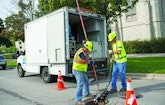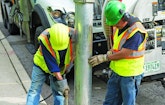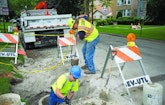
Interested in Rehab/Relining?
Get Rehab/Relining articles, news and videos right in your inbox! Sign up now.
Rehab/Relining + Get AlertsEvanston, Ill., has launched a three-pronged attack on stormwater overflows, but the increasing frequency and intensity of rain events is making the task more challenging.
Plagued for years with flooded basements and customer complaints, the utility has built a new system of stormwater relief sewers, added several new storm sewers, and installed flow restrictors which prevent storm drain overloads by forcing stormwater to pass down the street or alleyway to larger drains.
And while the system works well, Utilities Director Dave Stoneback says the heavier rainfalls the city has experienced in recent years can still cause flooding problems, especially in winter. A heavy rain last February on top of several inches of snow was especially problematic since the snow blocked storm drains and there was nowhere for the water to go.
“We used to talk about a 10-year storm event, but now it seems like it’s occurring every year. And the storms are more intense,” he says. “There’s no question we’re seeing a changing climate.”
A 200-mile collection system
Evanston does not own or operate its own wastewater treatment plant. Instead, the community sends its wastewater to the Metropolitan Water Reclamation District (MWRD) of Greater Chicago’s North Side Treatment Plant, a relationship Stoneback calls a “good partnership.”
That frees up the Evanston wastewater utility to concentrate its efforts on operating and maintaining the city’s 200-mile-long system of combined sanitary sewers, stormwater relief sewers and separate storm sewers.
“Our crews are responsible for preventive and routine maintenance on all three different sewer systems,” explains Stoneback. These systems are composed of sewer mains ranging from 6 to 120 inches in diameter and include over 5,500 manhole inspection structures and over 9,000 drainage structures. The majority of the combined system is constructed of vitrified clay, with the larger-diameter pipes constructed of brick or segmental clay tiles.
“We have our own [CUES] TV truck,” Stoneback says. “We inspect our drainage structures first, then the sewer pipes. Generally, we only TV under streets that are due for resurfacing the next year. That’s about 3 miles every year.
“We like to fix any problems before the resurfacing takes place,” he explains.
The Evanston team uses two Vactor combination sewer cleaning trucks, cleaning all drainage structures once every three years, operating on a third-third-third schedule. All sewer lines 24 inches and smaller are cleaned once every four years – all with in-house personnel.
When sewers need repair or replacement, Evanston relies primarily on cured-in-place pipe technology, using prequalified outside firms. “We’ve been using CIPP since the early 1980s,” Stoneback says. Current contractors include SAK, Michels, Insituform, Kenny and Visu-Sewer.
Annually, the city spends about half a million dollars on smaller-diameter (24-inch or less) sewer repair and replacement projects. For lining the larger-diameter sewers, 48-inch diameter or larger, Evanston has relied on low interest loans from the state revolving loan fund. “We just finished a $1.8 million project mostly using CIPP,” Stoneback says, “Where it’s advantageous on larger pipes, we will use slip-lining with fiberglass [Hobas Pipe USA].”
If the pipes are too out-of-round, or broken, crews will use open-cut trenching methods, soliciting bids from a range of qualified suppliers.
As for manholes, Stoneback says the maintenance crews keep an eye on them when they’re doing the pipeline cleaning. The city’s sewer schedule enables the crews to observe individual manholes at least once every three years.
Taking on stormwater
So far, so good, but Evanston must fight special battles against stormwater overflows. While the average citizen might rely on an umbrella for protection, Evanston employs a full toolbox of solutions, including improvements to the sewer system and flow restrictors. In addition, it’s investigating green methods like porous pavement and rain gardens.
Since 1985, Evanston has used a 250-foot-deep tunnel (part of the MWRD of Chicago’s deep tunnel system) to store combined sewer overflows. During heavy rains, however, Evanston residents continued to experience basement backups and property damage.
In 1990, the Evanston City Council approved a Long Range Sewer Improvement Program that included the installation of larger-diameter relief sewers that could convey stormwater and overflows to the deep tunnel, as well as an extension of the existing storm sewer system into the north central and east side of the city to convey surface drainage directly to the North Shore Channel – a surface impoundment. The plan also called for the installation of flow restrictors in streets and alleyways throughout the city.
The new relief sewer system consists of 8.75 miles of shallow, 60-foot-deep tunnels ranging in size from 60 to 120 inches in diameter and 39 miles of sewers 6 to 54 inches in diameter. The design was based on complete drainage of street flooding during a five-year storm and only minimal flooding in isolated areas during a 10-year storm.
Restricting and redirecting flow
The Reg-U-Flow restrictors come from Hydro International, and use a vortex motion to restrict the entry of water into drainage structures as the flow increases. They are positioned at hundreds of street curb drains throughout the city. (For even more information on Evanston's flow restrictors, see "Stormwater Management: The Flow Restrictor Solution.")
Under low flow conditions, the restrictors act as a large 2 1/2-inch orifice, letting water pass to the combined sewer system. When flow increases, however, the vortex action begins to throttle back the flow that is allowed to pass through the orifice. As head continues to increase, the valve discharge closes to a much smaller orifice, forcing stormwater to flow down the street for up to two blocks where it is intercepted by high capacity inlets that flow directly to the relief sewer system.
“The restrictors really protect our basements,” says Stoneback. “They keep the stormwater on the street and divert it to our relief sewers.
“They’ve worked well,” he adds. “They can clog, but maintenance has been manageable. Our crews use a two-part device that fits into the outfall pipe and pulls the vortex head up to the street. Their installation – all over the city – has been a money-saving event for us.”
Stoneback makes clear that the restrictors and the relief sewer system work together, in tandem. “We monitor results and find places where installing a restrictor into a drainage structure has caused unacceptable street flooding,” he says. “In that case, we’ll extend the relief sewer to that location.”
According to the city’s website, this innovative approach of partial sewer separation combined with street flow control was more cost-effective than installing a totally new separate storm sewer system throughout the entire 7.8-square-mile city area. In fact, the program, developed between 1991 and 2008, cost about $210 million.
It also received awards: the Pisces Award in 2006 for innovative use of the Illinois Clean Water Act Revolving Fund for water-quality improvements and the 2009 Illinois Section Award from the American Society of Civil Engineers.
Going green
Like many other forward-looking municipalities, Evanston is considering green solutions as part of its stormwater management plan. It’s in its infancy, as Stoneback explains it, and includes porous pavement, rain gardens and rain barrels.
“We’ve put in a lot of porous pavement in the last couple of years and have had mixed results,” he says. “In the parking lanes on Sheridan Road [a main drag], it’s worked well, but in the downtown, it’s not holding up as well. We’re diagnosing why.” He adds the city is installing porous pavement on selected residential streets where truck traffic is not heavy.
The city is also studying rain gardens, and has plans to develop one next to the parking lot at the municipal building.
Residents are encouraged to install rain barrels as well. “The MWRD has a good program in Chicago,” Stoneback says, adding that Evanston would like to duplicate it. “We’re hoping to find a contractor who would pick up the barrels and deliver them to the home site; they’re really too big and cumbersome to load into your car.”
He adds the city is also developing standards for installing and maintaining rain barrels.
Since the 1980s, a city ordinance has required that all roof downspouts be disconnected from the sewer system, but existing sump pump connections were grandfathered. Getting property owners to voluntarily move the pump discharge to the lawn rather than the sewer system is both a goal and a challenge.
“According to our calculations, if 18 sump pumps kicked on at the same time, that would overwhelm a 12-inch pipe,” he explains. “We continue to talk to aldermen about this issue, and go to public meetings advising homeowners of the problems sump pumps can cause and encouraging them to discharge to their lawns.”
Challenges ahead
Of course, at a municipal water and wastewater utility, the work never ends. As Stoneback and his department look ahead, they see continued funding and rehabilitation of existing infrastructure as serious challenges. But the biggest concern is climate change – the intensity and duration of storms and the city’s ability to deal with them.
“People get tired of hearing about the 100-year storm because it seems to be happening every year,” Stoneback says. “But our [weather] graphs are changing, we’re getting more intense storms. We’re learning that while our storm relief sewers are designed for the 10-year rain event, now it’s every five or six years. It has caused our relief sewers to surcharge, resulting in more standing water on our streets.”
More help is on the way, but it’s probably years in the future. The MWRD has plans to build the McCook reservoir to be able to accept and store more stormwater from Chicago and other communities – like Evanston – which are served by the Deep Tunnel system.
“So much of our system is dependent on MWRD,” says Stoneback. “They’ve helped us tremendously. But until McCook is built, we’ll probably still be susceptible to backups.”
More Information
CUES - 800/327-7791 - www.cuesinc.com
HOBAS Pipe USA - 800/856-7473 - www.hobaspipe.com
Hydro International - 866/615-8130 - www.hydro-int.com
Insituform Technologies - 800/234-2992 - www.insituform.com
Kenny Construction Co. - 847/919-8200 - www.kennyconstruction.com
Michels Corporation - 920/583-3132 - www.michels.us
SAK Construction - 636/385-1000 - www.sakconst.com
Vactor Manufacturing - 800/627-3171 - www.vactor.com
Visu-Sewer - 800/876-8478 - www.visu-sewer.com










